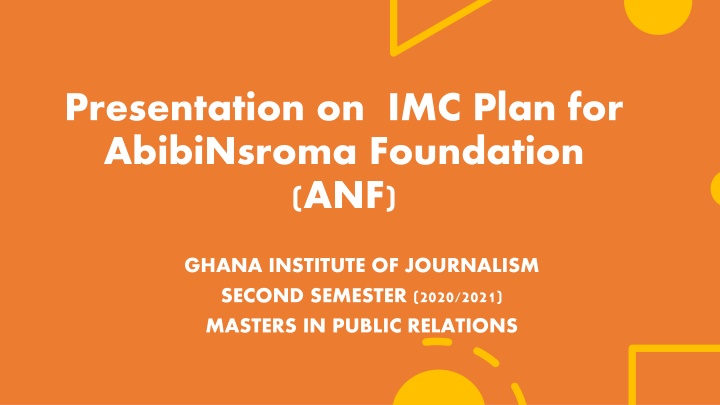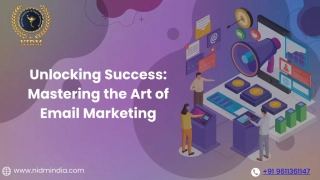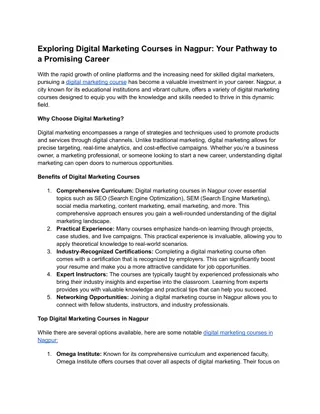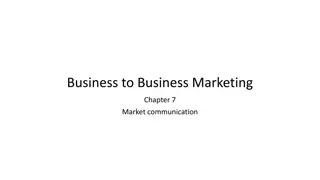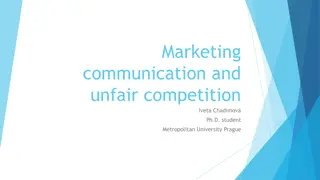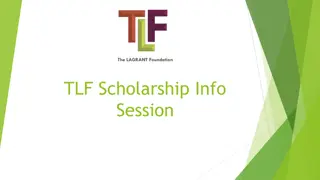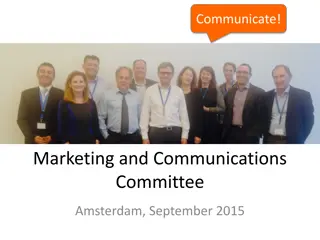Strategic Integrated Marketing Communications Plan for AbibiNsroma Foundation
AbibiNsroma Foundation (ANF) in Ghana focuses on grassroots empowerment for sustainable development. Their organizational objectives include community engagement, research, and advocacy in various sectors. ANF has successfully conducted webinars, broadcast interviews, and workshops to promote cooperation and development at the grassroots level.
Download Presentation

Please find below an Image/Link to download the presentation.
The content on the website is provided AS IS for your information and personal use only. It may not be sold, licensed, or shared on other websites without obtaining consent from the author.If you encounter any issues during the download, it is possible that the publisher has removed the file from their server.
You are allowed to download the files provided on this website for personal or commercial use, subject to the condition that they are used lawfully. All files are the property of their respective owners.
The content on the website is provided AS IS for your information and personal use only. It may not be sold, licensed, or shared on other websites without obtaining consent from the author.
E N D
Presentation Transcript
Presentation on IMC Plan for AbibiNsroma Foundation (ANF) GHANA INSTITUTE OF JOURNALISM SECOND SEMESTER (2020/2021) MASTERS IN PUBLIC RELATIONS
GROUP MEMBERS 4. FUMADORH PRISCILLA MAWUXORNAM MAPR20095 1. SELASI GLORIA KUGBLENU MAPR20086 2. SAMUEL OWUSU DARKWA MAPR20077 3. ALEXANDER ESEM DUMAKOR MAPR 20060 5. WENDY SEYRAM TSEY MAPR20082 6. ELIZABETH AGONOU MAPR 20006 7. SAMUEL SOMUAH NYARKO MAPR20140 8. NATHANIEL N. EKUE MENSAH MAPR20139 9. JOYCELYN ASARE-KONADU MAPR 20110 10. DICKSON KYERE-DUAH MAPR20149
Introduction Organizational Objectives AbibiNsroma Communication Objectives & Key Activities Successful Programs Research Analysis (SWOT /Industry Analysis) Target Audience Budget IMC Objectives Strategy IMC Tools Evaluation Recommendation Conclusion Q&A References Presentation outline
AbibiNsroma Foundation (ANF) is a not-for-profit, (REG CG024162020, DSW 2525), established in 2019 in Tema, Ghana, and committed to identifying, promoting and empowering grassroots to develop innovative solutions for the developmental challenges in Ghana and Africa. Introduction ANF works towards their objectives through capacity building, training, research, advocacy and community development in the areas of energy, climate change and environment, natural resources, education, health and agriculture, as well as water, sanitation and hygiene to enhance Sustainable Development
Organizational Objectives 1 2 3 4 5 6 Participate and collaborate actively in community engaging and empowering activities on National and Regional development. Promote understanding on the environmental, social and governance dynamics Contribute to the needed research and monitoring on African country-specific SDGs related programs and projects Facilitate the linkages between internal and external funding sources to deliver specific SDGs focused programs and projects. Enhance the quality of public education and awareness creation research, monitoring and evaluation on policies and practices. Highlight the impacts of best practices in policy formulation, policies linkages and their implementations on sustainable development.
Success story Webinar series targeting community-based organizations to promote cooperation, collaboration and partnerships for grassroots and community development. Nationwide broadcast of interviews on peaceful elections with heads of state Institutions and eminent Personalities. Workshops for 60 Eminent Personalities, vital state institutions and agencies on the implementation of the Early Intervention Mechanism (EIMs) aimed at promoting cooperation, collaborations and partnerships for grassroots and community development and to manage potential tensions and conflict situations before they escalate. Elections Watch programme for the mobilization of over 10,000 local electoral observation and monitoring groups from over 1,500 community- based organizations to generate data and report on the electoral process.
SWOT Analysis Strengths Existing partners and donors: Strong Brand Equity and Brand Awareness: Managing Regulations and Business Environment. Weakness Lack of Work force diversity Organizational Culture and bureaucracy Opportunities Changing Technology Landscape Opportunities in International Markets Threats Threats of new entrants Government Regulations and Bureaucracy
Developing countries and their municipal assemblies Target Audience Rural areas especially farmers and small-scale industry owners Urban dwellers and the working class
Budget NO COMMUNICATION TOOL MEDIUM ESTIMATED FUNDING % 1. Public Relations Publicity I. Press Kits 3.43% II. Publications 17.15% 1. Events and Experiences Entertainments and 28.57% Sponsorship 1. Advertising 42.85% 1. Miscellaneous 8% 1. Grand Total 100%
To Deliver a Consistent Message across all channels To Focus on Results /objectives IMC Objectives To Build Brand s Image in people s minds To Create a Consumer Experience To Generate Cost Savings
Strategy The main strategy should be directed at achieving the aims and objectives of the Foundation as stated above. In the most basic sense, IMC is the act of coordinating or unifying marketing messages at the various points of contact or channels. It s the process of melting all aspects of marketing communications, including social media, public relations, press, sales promotion, advertising, and direct marketing, through their respective blend of tactics, channels, media, methods, and other activities. IMC lets you unify the various marketing and communication components and make them work together towards a common goal. Although AbibiNsroma has been around for over twenty years, the impact on the targeted audience has not been successful due to the lack of properly coordinated IMC strategy.
Public Relations and Publicity Exhibitions Point of Sale Merchandising IMC Tools Advertising Word of Mouth Marketing Events and Experience
NO COMMUNICATION MEDIUM DURATION JUSTIFICATION TOOL 1. Public Relations I. Press Kits News item to be To maintain mutually beneficial Publicity II. Publications published every 6 relationship between the months. organization and its various publics 2. Events and Entertainments Every quarter To effectively be remembered Experiences and by the various stakeholders. Sponsorship 3. Point of sale merchandising 4. Advertising Brochures and billboards are 5. Exhibitions As and when is available.
Monitoring and Evaluation To ensure that the AbibiNsroma Foundation have successfully implemented its Integrated Marketing Communication Plan to achieve the Foundation s objectives, Monitoring and Evaluation cannot be overlooked. The Foundation would have to frequently carry out an evaluation of their objectives to among other things measure the level of recall in terms of cognitive and affective levels of their target audience. Through the evaluation, the Foundation is able to access the extent to which its campaign messages resonate with its target audience and how it has impacted their livelihoods.
The IMC Plan be deliberately implemented to ensure achievement of the Foundation s objectives A well-qualified team of Public Relations Professionals be recruited Develop a strategic partnership with the media and influencers Recommendation Put in place a well-coordinated social media team to keep the public engaged IMC should not be seen as a one-off campaign but an ongoing process.
Conclusion Every organization both profit - making and not - for - profit needs a strategic communication to enable them deliver clear and consistent messages about their organization and its products. It is therefore imperative that every organization understands its target markets and their needs in order to communicate with them effectively while achieving their organizational goals. Not forgetting that a good Integrated Marketing Communication Plan will ensure everyone is on the same page on: It makes a lot of sense to have a consistent, more focused marketing and communication strategy, minus the pitfalls of becoming a company with no identity or, even worse, a contradictory identity.
References Fill, C. (2002). Marketing Communications: Contexts, Strategies and Applications. Third Edition. Prentice Hall. Marketing Communication, 1st Edition, 2014 Olumiji Kayode& bookboon.com, ISBN 978-87-403- 0674-3 Belch and Belch (2012). Advertising and Promotion:An Integrated Marketing Communications Perspective. McGraw-Hill, Boston. The Process of innovation and the Diffusion of Innovation. Thomas S. Robertson. Journal of Marketing Vol. 31, No. (Jan. 1967), pp. 14-19: American Marketing Association Vanden Bergh, G.B and Katz, H. (1999). Advertising Principles: Choice, Challenge and Change. Lincolnwood, Illinois: NTC Business Books. Warshaw, R.M Engel, J.T and Kinnear, C.T (1983). Promotional Strategy. Homewood, Illinois: Richard D. Irwin. "Integrated Marketing Communications." Dolan, Robert J. "Integrated Marketing Communications." Harvard Business School Background Note 599-087, February 1999. (Revised June 2000.)
Q&A Thank you
